ECO113 Business Economics Assignment: Oligopolistic Pricing
VerifiedAdded on 2022/04/26
|17
|5506
|87
Homework Assignment
AI Summary
This assignment explores the economic theories of oligopolistic pricing, focusing on the kinked-demand curve, cartel model, and price leadership model. It explains how firms in an oligopoly determine pricing strategies, considering the interdependence of firms and their reactions to price changes. The assignment delves into the characteristics of oligopolies, such as price stability and coordinated price changes, and examines the core concepts of each pricing model. The kinked-demand theory explains price rigidity, while the cartel model discusses collusion to maximize profits, and the price leadership model describes how a dominant firm sets prices. Real-world examples, such as OPEC and Reliance JIO, are used to illustrate these concepts. The assignment highlights the challenges of maintaining cartels and the factors influencing price leadership, providing a comprehensive overview of oligopolistic pricing in business economics.
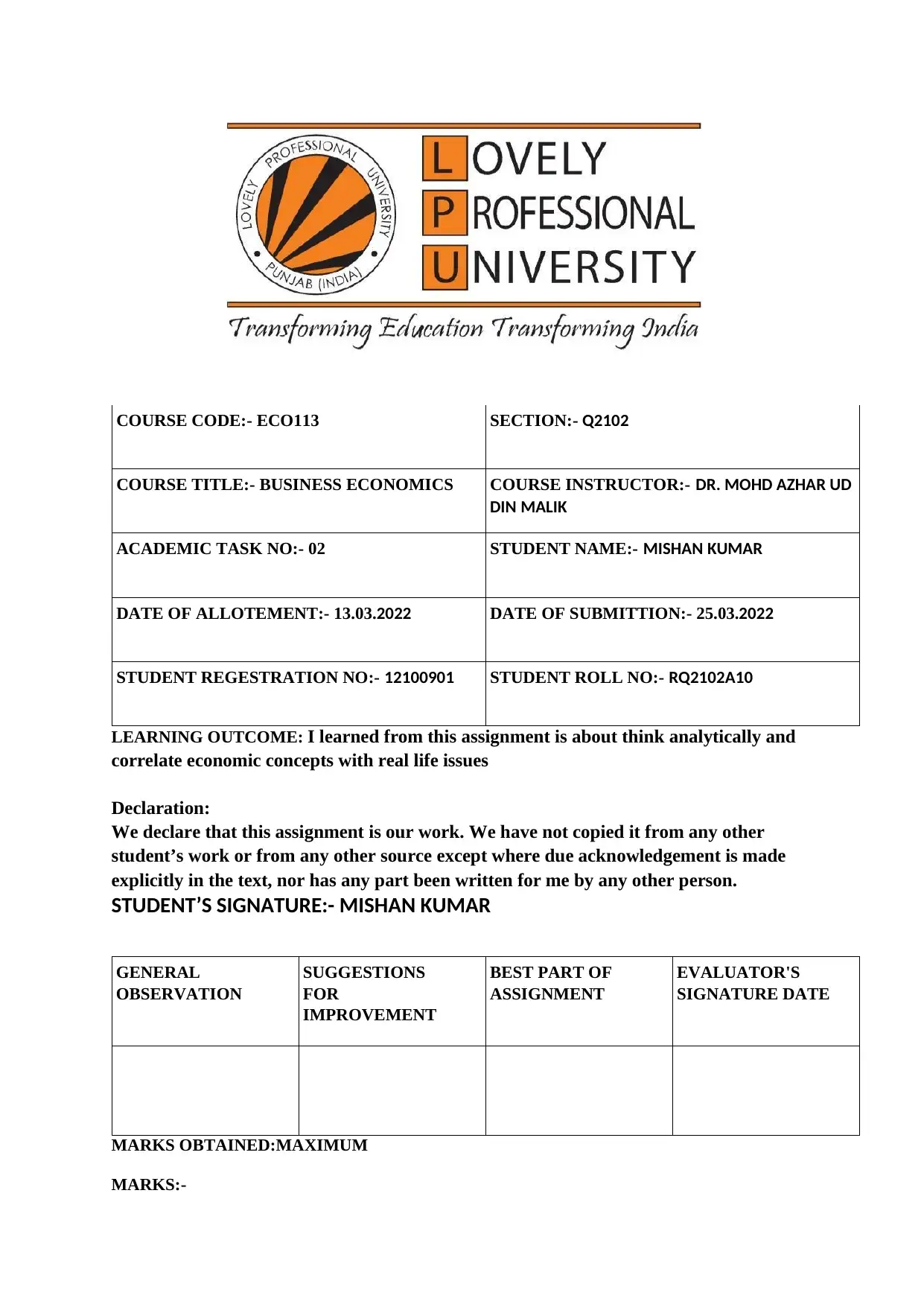
COURSE CODE:- ECO113 SECTION:- Q2102
COURSE TITLE:- BUSINESS ECONOMICS COURSE INSTRUCTOR:- DR. MOHD AZHAR UD
DIN MALIK
ACADEMIC TASK NO:- 02 STUDENT NAME:- MISHAN KUMAR
DATE OF ALLOTEMENT:- 13.03.2022 DATE OF SUBMITTION:- 25.03.2022
STUDENT REGESTRATION NO:- 12100901 STUDENT ROLL NO:- RQ2102A10
LEARNING OUTCOME: I learned from this assignment is about think analytically and
correlate economic concepts with real life issues
Declaration:
We declare that this assignment is our work. We have not copied it from any other
student’s work or from any other source except where due acknowledgement is made
explicitly in the text, nor has any part been written for me by any other person.
STUDENT’S SIGNATURE:- MISHAN KUMAR
GENERAL
OBSERVATION
SUGGESTIONS
FOR
IMPROVEMENT
BEST PART OF
ASSIGNMENT
EVALUATOR'S
SIGNATURE DATE
MARKS OBTAINED:MAXIMUM
MARKS:-
COURSE TITLE:- BUSINESS ECONOMICS COURSE INSTRUCTOR:- DR. MOHD AZHAR UD
DIN MALIK
ACADEMIC TASK NO:- 02 STUDENT NAME:- MISHAN KUMAR
DATE OF ALLOTEMENT:- 13.03.2022 DATE OF SUBMITTION:- 25.03.2022
STUDENT REGESTRATION NO:- 12100901 STUDENT ROLL NO:- RQ2102A10
LEARNING OUTCOME: I learned from this assignment is about think analytically and
correlate economic concepts with real life issues
Declaration:
We declare that this assignment is our work. We have not copied it from any other
student’s work or from any other source except where due acknowledgement is made
explicitly in the text, nor has any part been written for me by any other person.
STUDENT’S SIGNATURE:- MISHAN KUMAR
GENERAL
OBSERVATION
SUGGESTIONS
FOR
IMPROVEMENT
BEST PART OF
ASSIGNMENT
EVALUATOR'S
SIGNATURE DATE
MARKS OBTAINED:MAXIMUM
MARKS:-
Paraphrase This Document
Need a fresh take? Get an instant paraphrase of this document with our AI Paraphraser
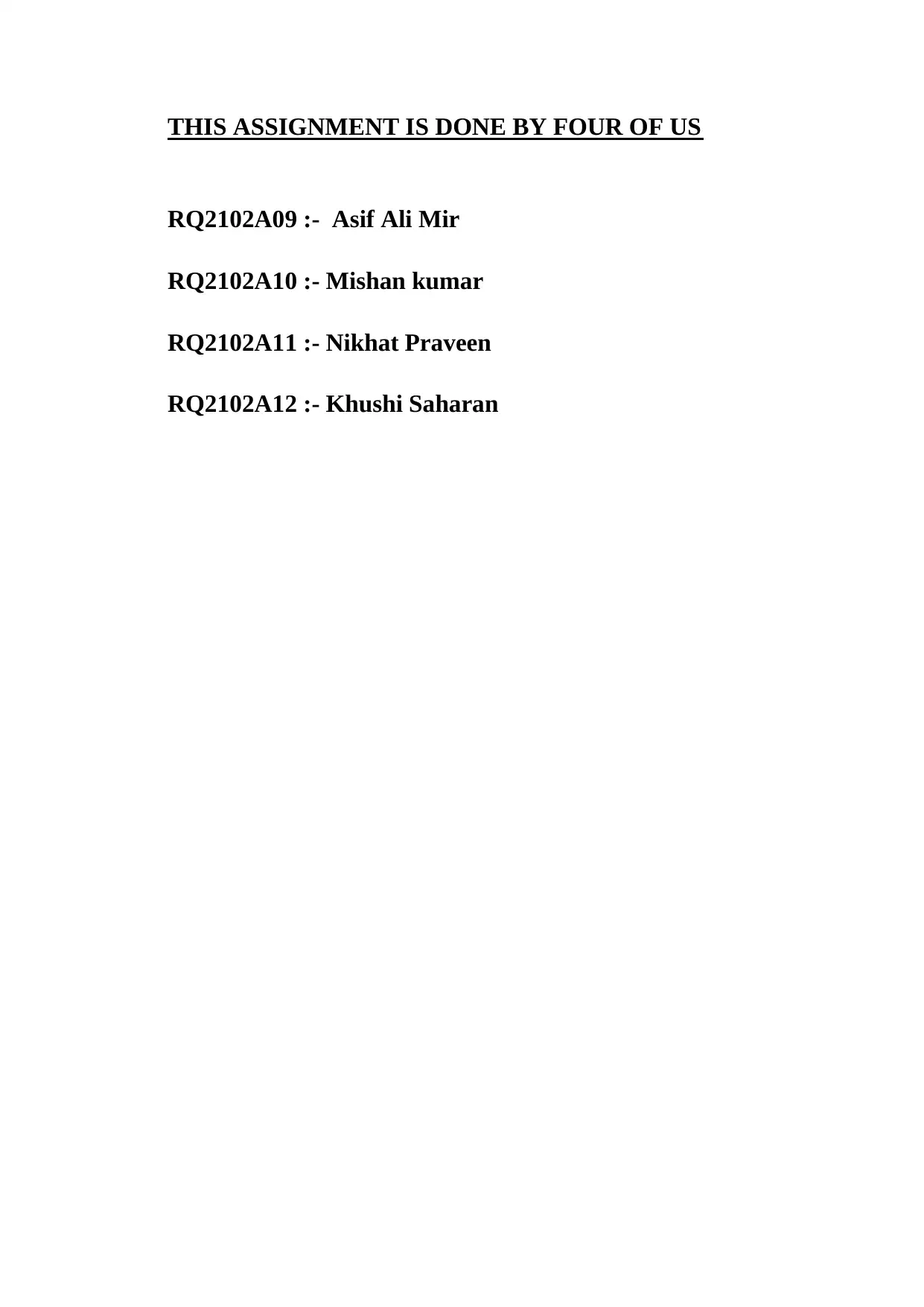
THIS ASSIGNMENT IS DONE BY FOUR OF US
RQ2102A09 :- Asif Ali Mir
RQ2102A10 :- Mishan kumar
RQ2102A11 :- Nikhat Praveen
RQ2102A12 :- Khushi Saharan
RQ2102A09 :- Asif Ali Mir
RQ2102A10 :- Mishan kumar
RQ2102A11 :- Nikhat Praveen
RQ2102A12 :- Khushi Saharan
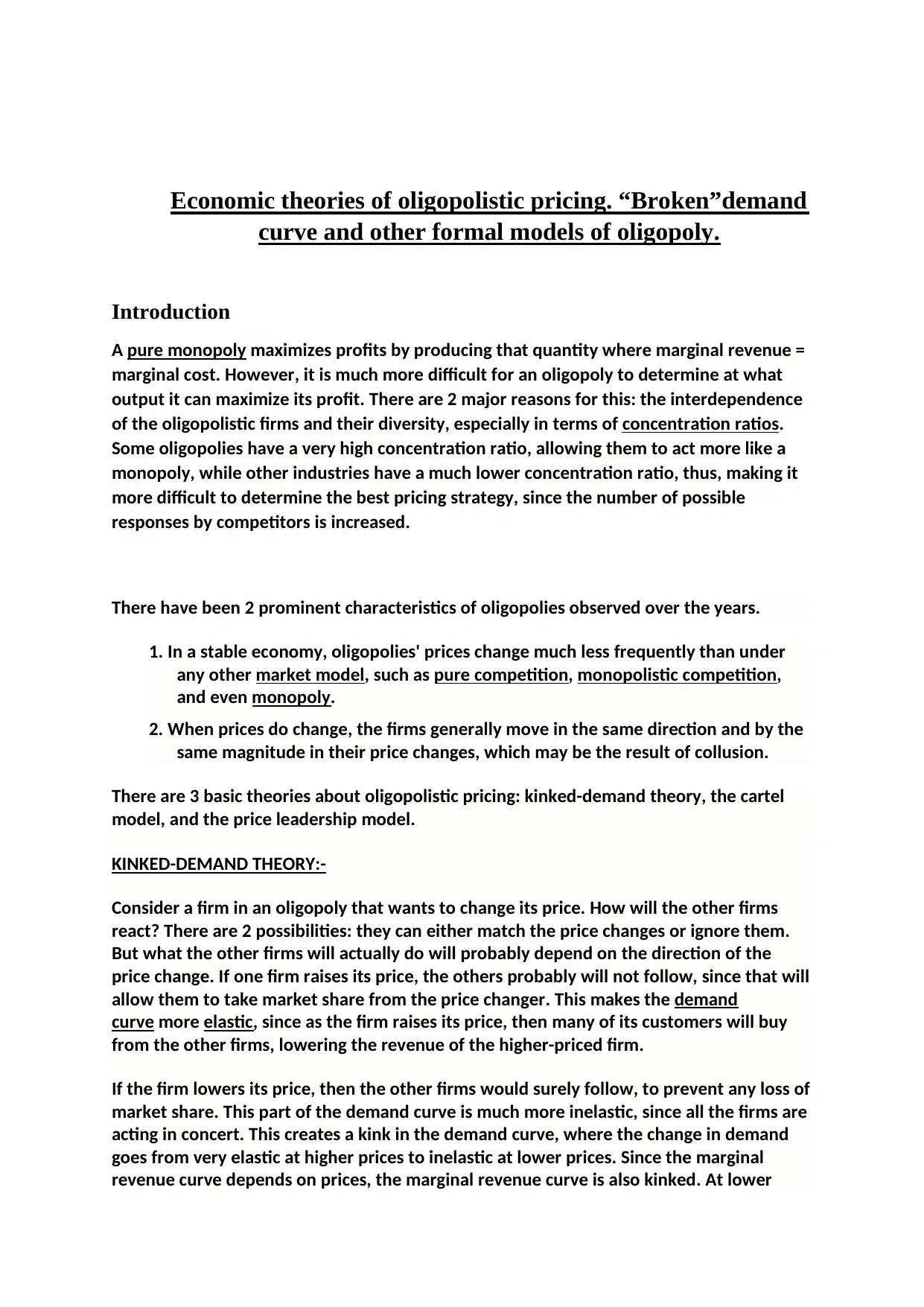
Economic theories of oligopolistic pricing. “Broken”demand
curve and other formal models of oligopoly.
Introduction
A pure monopoly maximizes profits by producing that quantity where marginal revenue =
marginal cost. However, it is much more difficult for an oligopoly to determine at what
output it can maximize its profit. There are 2 major reasons for this: the interdependence
of the oligopolistic firms and their diversity, especially in terms of concentration ratios.
Some oligopolies have a very high concentration ratio, allowing them to act more like a
monopoly, while other industries have a much lower concentration ratio, thus, making it
more difficult to determine the best pricing strategy, since the number of possible
responses by competitors is increased.
There have been 2 prominent characteristics of oligopolies observed over the years.
1. In a stable economy, oligopolies' prices change much less frequently than under
any other market model, such as pure competition, monopolistic competition,
and even monopoly.
2. When prices do change, the firms generally move in the same direction and by the
same magnitude in their price changes, which may be the result of collusion.
There are 3 basic theories about oligopolistic pricing: kinked-demand theory, the cartel
model, and the price leadership model.
KINKED-DEMAND THEORY:-
Consider a firm in an oligopoly that wants to change its price. How will the other firms
react? There are 2 possibilities: they can either match the price changes or ignore them.
But what the other firms will actually do will probably depend on the direction of the
price change. If one firm raises its price, the others probably will not follow, since that will
allow them to take market share from the price changer. This makes the demand
curve more elastic, since as the firm raises its price, then many of its customers will buy
from the other firms, lowering the revenue of the higher-priced firm.
If the firm lowers its price, then the other firms would surely follow, to prevent any loss of
market share. This part of the demand curve is much more inelastic, since all the firms are
acting in concert. This creates a kink in the demand curve, where the change in demand
goes from very elastic at higher prices to inelastic at lower prices. Since the marginal
revenue curve depends on prices, the marginal revenue curve is also kinked. At lower
curve and other formal models of oligopoly.
Introduction
A pure monopoly maximizes profits by producing that quantity where marginal revenue =
marginal cost. However, it is much more difficult for an oligopoly to determine at what
output it can maximize its profit. There are 2 major reasons for this: the interdependence
of the oligopolistic firms and their diversity, especially in terms of concentration ratios.
Some oligopolies have a very high concentration ratio, allowing them to act more like a
monopoly, while other industries have a much lower concentration ratio, thus, making it
more difficult to determine the best pricing strategy, since the number of possible
responses by competitors is increased.
There have been 2 prominent characteristics of oligopolies observed over the years.
1. In a stable economy, oligopolies' prices change much less frequently than under
any other market model, such as pure competition, monopolistic competition,
and even monopoly.
2. When prices do change, the firms generally move in the same direction and by the
same magnitude in their price changes, which may be the result of collusion.
There are 3 basic theories about oligopolistic pricing: kinked-demand theory, the cartel
model, and the price leadership model.
KINKED-DEMAND THEORY:-
Consider a firm in an oligopoly that wants to change its price. How will the other firms
react? There are 2 possibilities: they can either match the price changes or ignore them.
But what the other firms will actually do will probably depend on the direction of the
price change. If one firm raises its price, the others probably will not follow, since that will
allow them to take market share from the price changer. This makes the demand
curve more elastic, since as the firm raises its price, then many of its customers will buy
from the other firms, lowering the revenue of the higher-priced firm.
If the firm lowers its price, then the other firms would surely follow, to prevent any loss of
market share. This part of the demand curve is much more inelastic, since all the firms are
acting in concert. This creates a kink in the demand curve, where the change in demand
goes from very elastic at higher prices to inelastic at lower prices. Since the marginal
revenue curve depends on prices, the marginal revenue curve is also kinked. At lower
⊘ This is a preview!⊘
Do you want full access?
Subscribe today to unlock all pages.

Trusted by 1+ million students worldwide
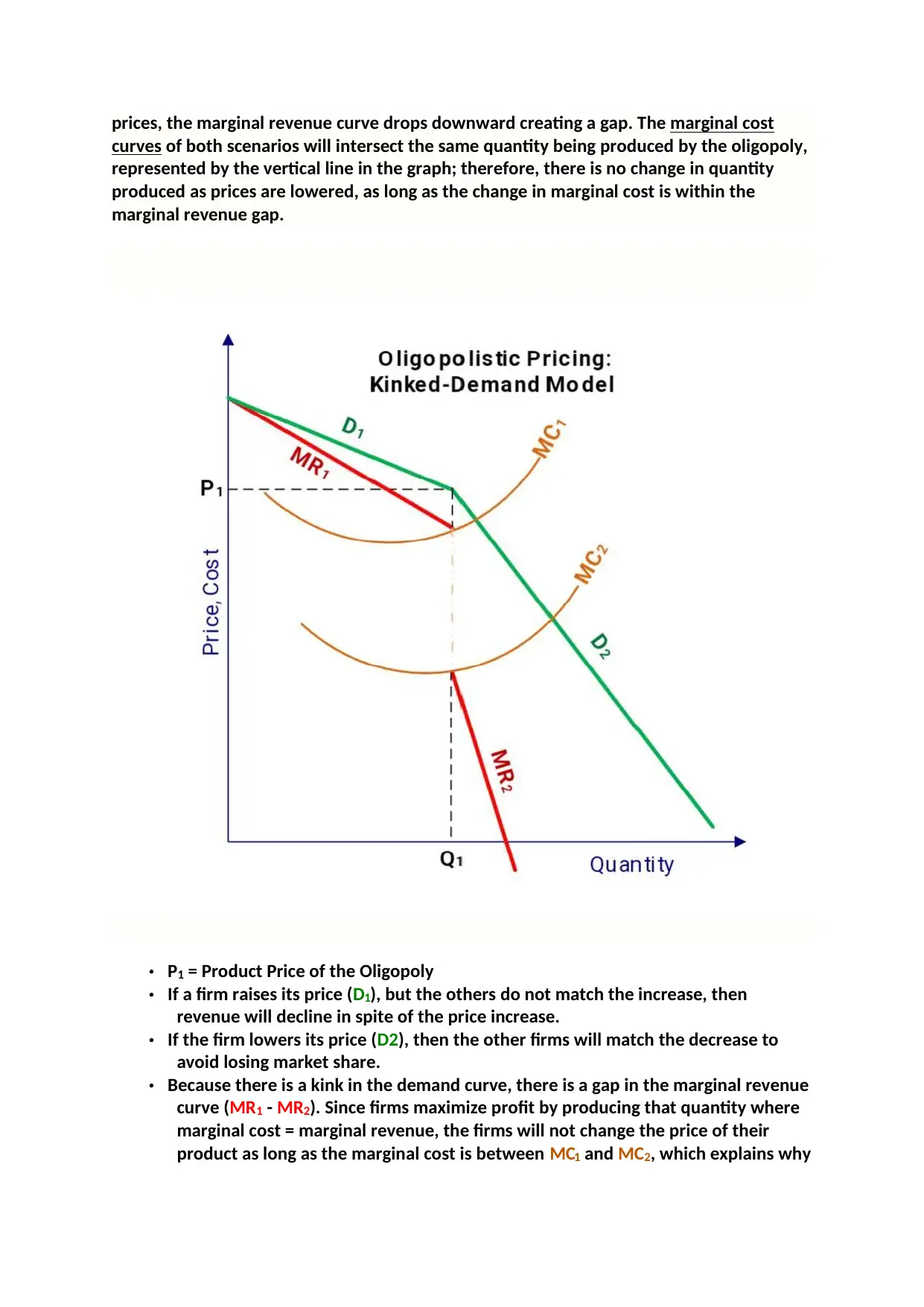
prices, the marginal revenue curve drops downward creating a gap. The marginal cost
curves of both scenarios will intersect the same quantity being produced by the oligopoly,
represented by the vertical line in the graph; therefore, there is no change in quantity
produced as prices are lowered, as long as the change in marginal cost is within the
marginal revenue gap.
• P1 = Product Price of the Oligopoly
• If a firm raises its price (D1), but the others do not match the increase, then
revenue will decline in spite of the price increase.
• If the firm lowers its price (D2), then the other firms will match the decrease to
avoid losing market share.
• Because there is a kink in the demand curve, there is a gap in the marginal revenue
curve (MR1 - MR2). Since firms maximize profit by producing that quantity where
marginal cost = marginal revenue, the firms will not change the price of their
product as long as the marginal cost is between MC1 and MC2, which explains why
curves of both scenarios will intersect the same quantity being produced by the oligopoly,
represented by the vertical line in the graph; therefore, there is no change in quantity
produced as prices are lowered, as long as the change in marginal cost is within the
marginal revenue gap.
• P1 = Product Price of the Oligopoly
• If a firm raises its price (D1), but the others do not match the increase, then
revenue will decline in spite of the price increase.
• If the firm lowers its price (D2), then the other firms will match the decrease to
avoid losing market share.
• Because there is a kink in the demand curve, there is a gap in the marginal revenue
curve (MR1 - MR2). Since firms maximize profit by producing that quantity where
marginal cost = marginal revenue, the firms will not change the price of their
product as long as the marginal cost is between MC1 and MC2, which explains why
Paraphrase This Document
Need a fresh take? Get an instant paraphrase of this document with our AI Paraphraser
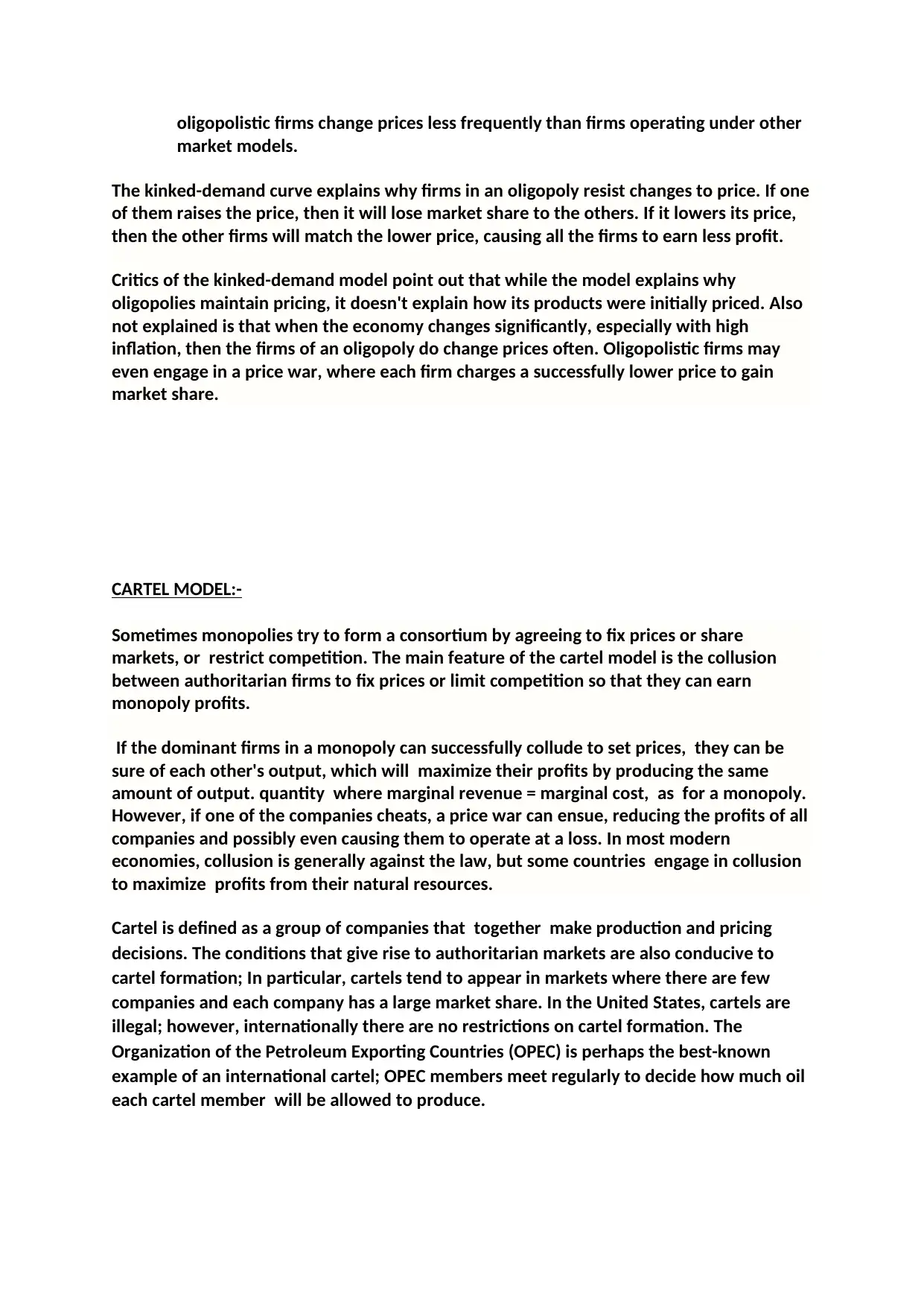
oligopolistic firms change prices less frequently than firms operating under other
market models.
The kinked-demand curve explains why firms in an oligopoly resist changes to price. If one
of them raises the price, then it will lose market share to the others. If it lowers its price,
then the other firms will match the lower price, causing all the firms to earn less profit.
Critics of the kinked-demand model point out that while the model explains why
oligopolies maintain pricing, it doesn't explain how its products were initially priced. Also
not explained is that when the economy changes significantly, especially with high
inflation, then the firms of an oligopoly do change prices often. Oligopolistic firms may
even engage in a price war, where each firm charges a successfully lower price to gain
market share.
CARTEL MODEL:-
Sometimes monopolies try to form a consortium by agreeing to fix prices or share
markets, or restrict competition. The main feature of the cartel model is the collusion
between authoritarian firms to fix prices or limit competition so that they can earn
monopoly profits.
If the dominant firms in a monopoly can successfully collude to set prices, they can be
sure of each other's output, which will maximize their profits by producing the same
amount of output. quantity where marginal revenue = marginal cost, as for a monopoly.
However, if one of the companies cheats, a price war can ensue, reducing the profits of all
companies and possibly even causing them to operate at a loss. In most modern
economies, collusion is generally against the law, but some countries engage in collusion
to maximize profits from their natural resources.
Cartel is defined as a group of companies that together make production and pricing
decisions. The conditions that give rise to authoritarian markets are also conducive to
cartel formation; In particular, cartels tend to appear in markets where there are few
companies and each company has a large market share. In the United States, cartels are
illegal; however, internationally there are no restrictions on cartel formation. The
Organization of the Petroleum Exporting Countries (OPEC) is perhaps the best-known
example of an international cartel; OPEC members meet regularly to decide how much oil
each cartel member will be allowed to produce.
market models.
The kinked-demand curve explains why firms in an oligopoly resist changes to price. If one
of them raises the price, then it will lose market share to the others. If it lowers its price,
then the other firms will match the lower price, causing all the firms to earn less profit.
Critics of the kinked-demand model point out that while the model explains why
oligopolies maintain pricing, it doesn't explain how its products were initially priced. Also
not explained is that when the economy changes significantly, especially with high
inflation, then the firms of an oligopoly do change prices often. Oligopolistic firms may
even engage in a price war, where each firm charges a successfully lower price to gain
market share.
CARTEL MODEL:-
Sometimes monopolies try to form a consortium by agreeing to fix prices or share
markets, or restrict competition. The main feature of the cartel model is the collusion
between authoritarian firms to fix prices or limit competition so that they can earn
monopoly profits.
If the dominant firms in a monopoly can successfully collude to set prices, they can be
sure of each other's output, which will maximize their profits by producing the same
amount of output. quantity where marginal revenue = marginal cost, as for a monopoly.
However, if one of the companies cheats, a price war can ensue, reducing the profits of all
companies and possibly even causing them to operate at a loss. In most modern
economies, collusion is generally against the law, but some countries engage in collusion
to maximize profits from their natural resources.
Cartel is defined as a group of companies that together make production and pricing
decisions. The conditions that give rise to authoritarian markets are also conducive to
cartel formation; In particular, cartels tend to appear in markets where there are few
companies and each company has a large market share. In the United States, cartels are
illegal; however, internationally there are no restrictions on cartel formation. The
Organization of the Petroleum Exporting Countries (OPEC) is perhaps the best-known
example of an international cartel; OPEC members meet regularly to decide how much oil
each cartel member will be allowed to produce.
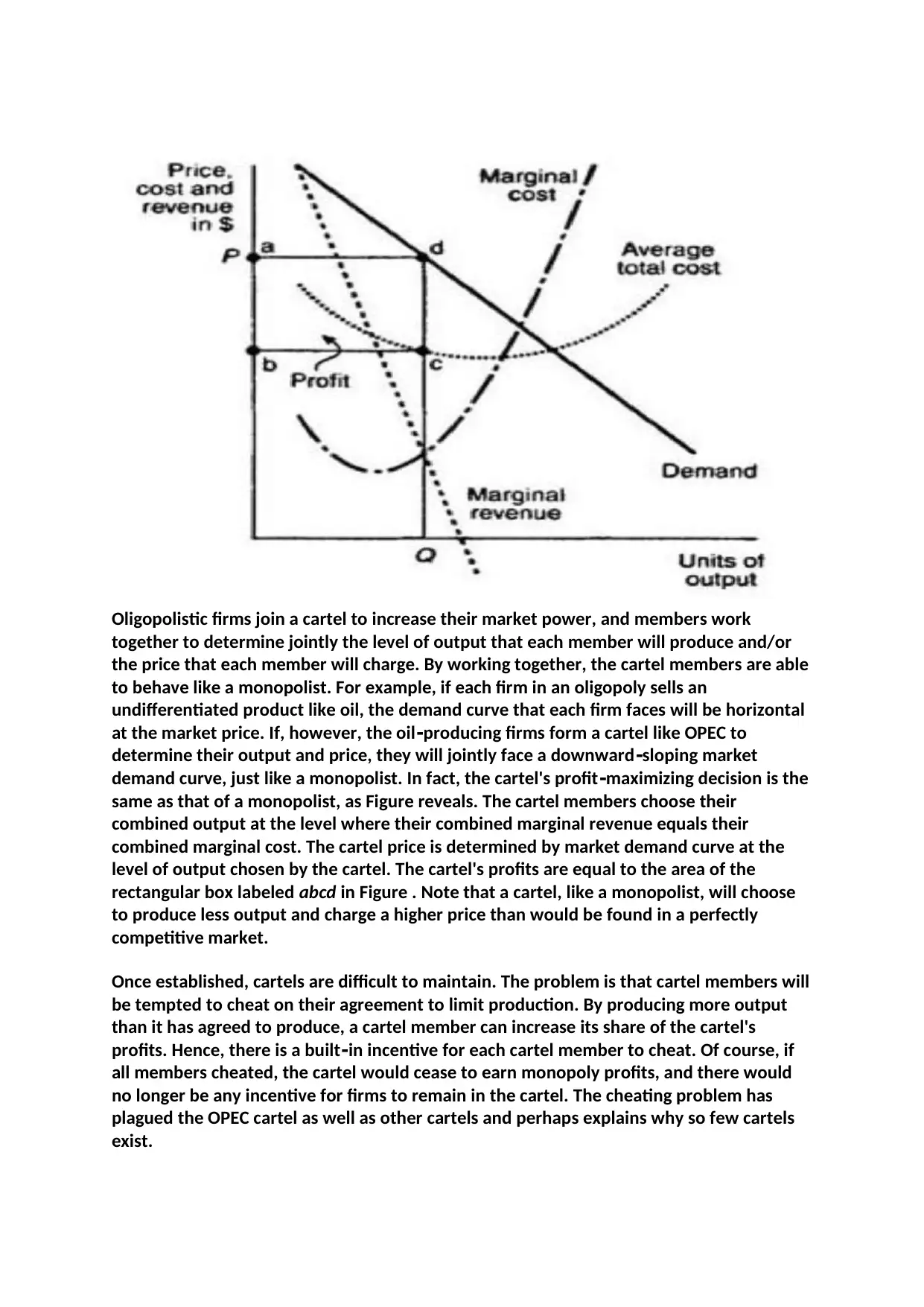
Oligopolistic firms join a cartel to increase their market power, and members work
together to determine jointly the level of output that each member will produce and/or
the price that each member will charge. By working together, the cartel members are able
to behave like a monopolist. For example, if each firm in an oligopoly sells an
undifferentiated product like oil, the demand curve that each firm faces will be horizontal
at the market price. If, however, the oil producing firms form a cartel like OPEC to‐
determine their output and price, they will jointly face a downward sloping market‐
demand curve, just like a monopolist. In fact, the cartel's profit maximizing decision is the‐
same as that of a monopolist, as Figure reveals. The cartel members choose their
combined output at the level where their combined marginal revenue equals their
combined marginal cost. The cartel price is determined by market demand curve at the
level of output chosen by the cartel. The cartel's profits are equal to the area of the
rectangular box labeled abcd in Figure . Note that a cartel, like a monopolist, will choose
to produce less output and charge a higher price than would be found in a perfectly
competitive market.
Once established, cartels are difficult to maintain. The problem is that cartel members will
be tempted to cheat on their agreement to limit production. By producing more output
than it has agreed to produce, a cartel member can increase its share of the cartel's
profits. Hence, there is a built in incentive for each cartel member to cheat. Of course, if‐
all members cheated, the cartel would cease to earn monopoly profits, and there would
no longer be any incentive for firms to remain in the cartel. The cheating problem has
plagued the OPEC cartel as well as other cartels and perhaps explains why so few cartels
exist.
together to determine jointly the level of output that each member will produce and/or
the price that each member will charge. By working together, the cartel members are able
to behave like a monopolist. For example, if each firm in an oligopoly sells an
undifferentiated product like oil, the demand curve that each firm faces will be horizontal
at the market price. If, however, the oil producing firms form a cartel like OPEC to‐
determine their output and price, they will jointly face a downward sloping market‐
demand curve, just like a monopolist. In fact, the cartel's profit maximizing decision is the‐
same as that of a monopolist, as Figure reveals. The cartel members choose their
combined output at the level where their combined marginal revenue equals their
combined marginal cost. The cartel price is determined by market demand curve at the
level of output chosen by the cartel. The cartel's profits are equal to the area of the
rectangular box labeled abcd in Figure . Note that a cartel, like a monopolist, will choose
to produce less output and charge a higher price than would be found in a perfectly
competitive market.
Once established, cartels are difficult to maintain. The problem is that cartel members will
be tempted to cheat on their agreement to limit production. By producing more output
than it has agreed to produce, a cartel member can increase its share of the cartel's
profits. Hence, there is a built in incentive for each cartel member to cheat. Of course, if‐
all members cheated, the cartel would cease to earn monopoly profits, and there would
no longer be any incentive for firms to remain in the cartel. The cheating problem has
plagued the OPEC cartel as well as other cartels and perhaps explains why so few cartels
exist.
⊘ This is a preview!⊘
Do you want full access?
Subscribe today to unlock all pages.

Trusted by 1+ million students worldwide
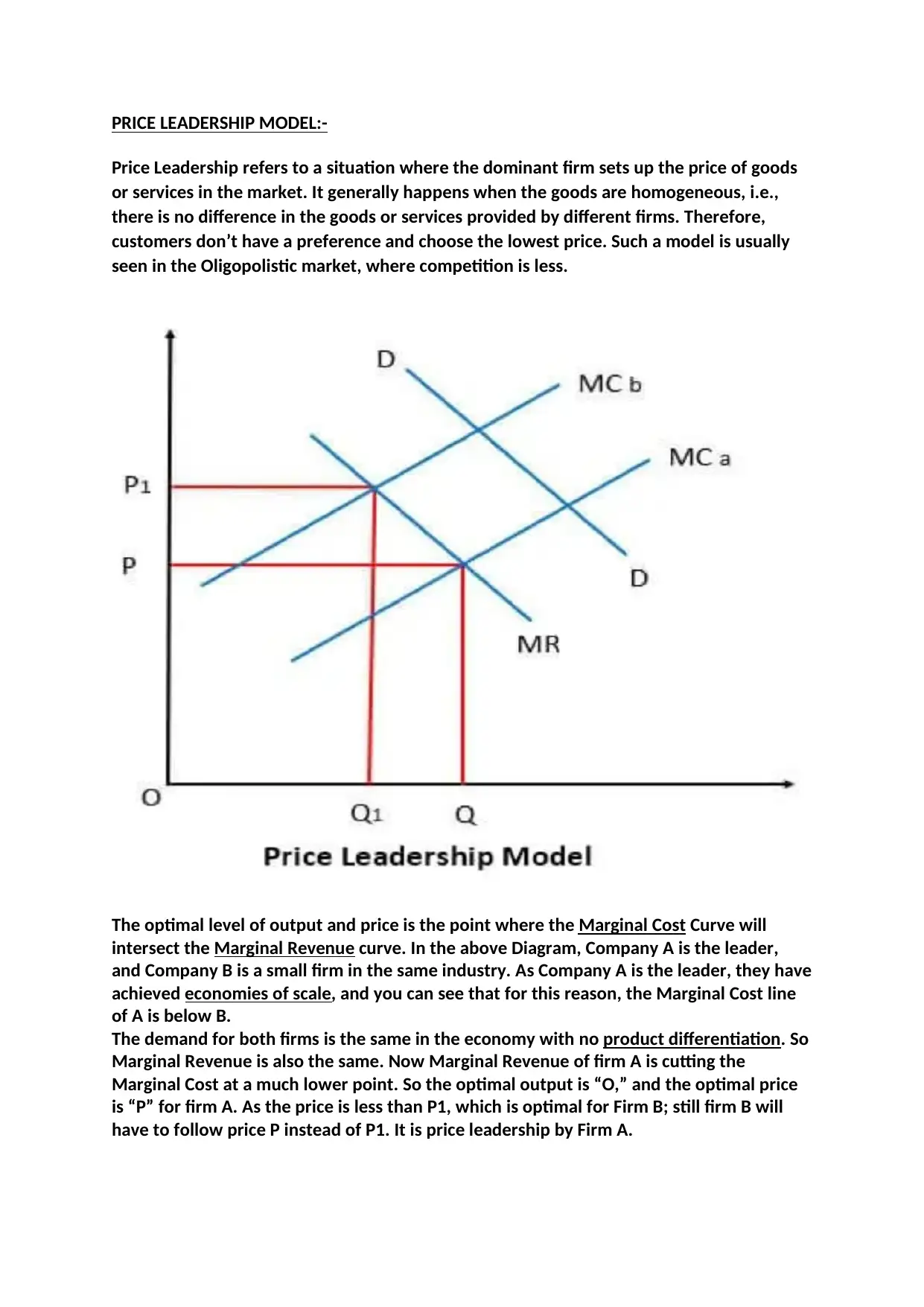
PRICE LEADERSHIP MODEL:-
Price Leadership refers to a situation where the dominant firm sets up the price of goods
or services in the market. It generally happens when the goods are homogeneous, i.e.,
there is no difference in the goods or services provided by different firms. Therefore,
customers don’t have a preference and choose the lowest price. Such a model is usually
seen in the Oligopolistic market, where competition is less.
The optimal level of output and price is the point where the Marginal Cost Curve will
intersect the Marginal Revenue curve. In the above Diagram, Company A is the leader,
and Company B is a small firm in the same industry. As Company A is the leader, they have
achieved economies of scale, and you can see that for this reason, the Marginal Cost line
of A is below B.
The demand for both firms is the same in the economy with no product differentiation. So
Marginal Revenue is also the same. Now Marginal Revenue of firm A is cutting the
Marginal Cost at a much lower point. So the optimal output is “O,” and the optimal price
is “P” for firm A. As the price is less than P1, which is optimal for Firm B; still firm B will
have to follow price P instead of P1. It is price leadership by Firm A.
Price Leadership refers to a situation where the dominant firm sets up the price of goods
or services in the market. It generally happens when the goods are homogeneous, i.e.,
there is no difference in the goods or services provided by different firms. Therefore,
customers don’t have a preference and choose the lowest price. Such a model is usually
seen in the Oligopolistic market, where competition is less.
The optimal level of output and price is the point where the Marginal Cost Curve will
intersect the Marginal Revenue curve. In the above Diagram, Company A is the leader,
and Company B is a small firm in the same industry. As Company A is the leader, they have
achieved economies of scale, and you can see that for this reason, the Marginal Cost line
of A is below B.
The demand for both firms is the same in the economy with no product differentiation. So
Marginal Revenue is also the same. Now Marginal Revenue of firm A is cutting the
Marginal Cost at a much lower point. So the optimal output is “O,” and the optimal price
is “P” for firm A. As the price is less than P1, which is optimal for Firm B; still firm B will
have to follow price P instead of P1. It is price leadership by Firm A.
Paraphrase This Document
Need a fresh take? Get an instant paraphrase of this document with our AI Paraphraser
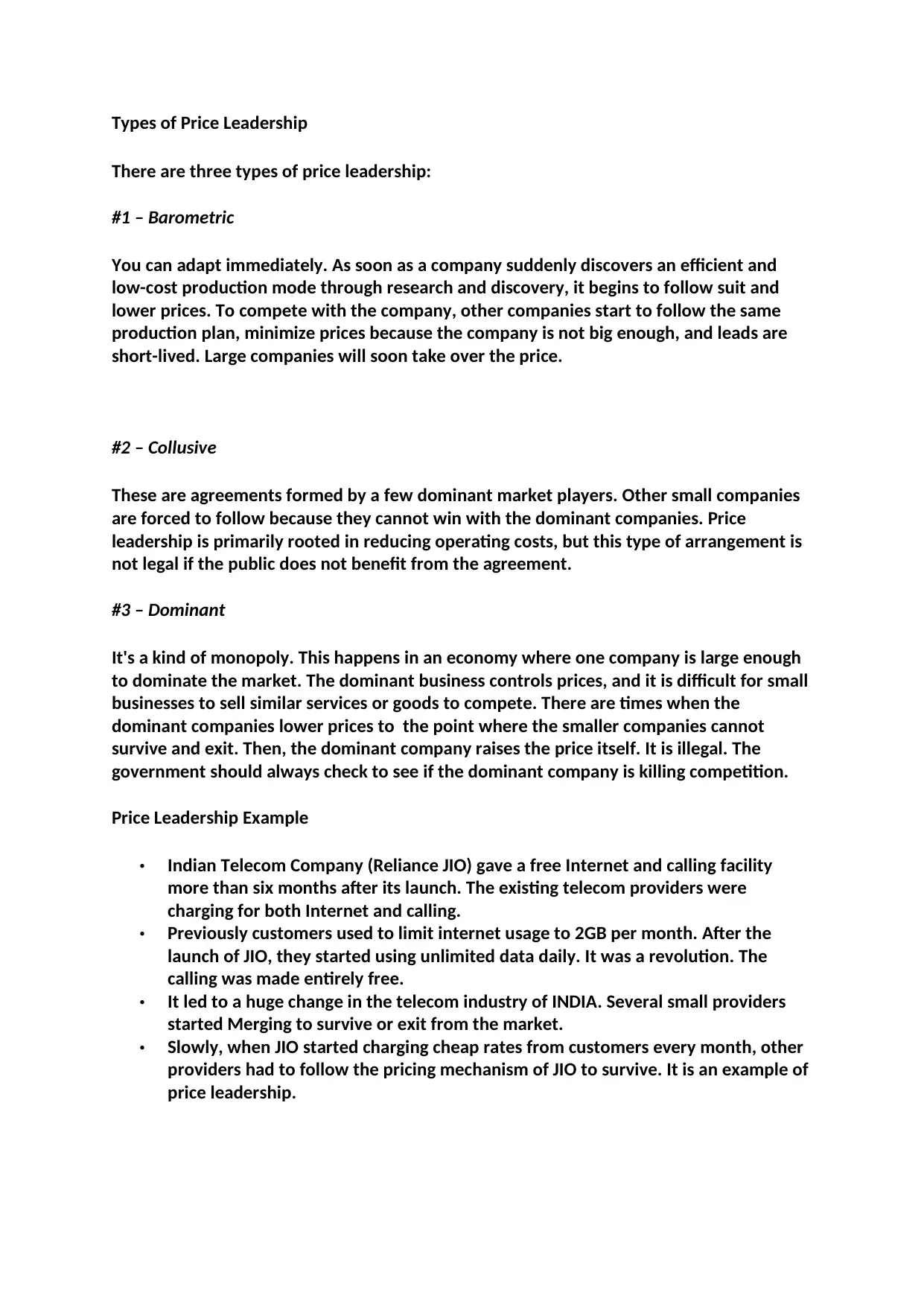
Types of Price Leadership
There are three types of price leadership:
#1 – Barometric
You can adapt immediately. As soon as a company suddenly discovers an efficient and
low-cost production mode through research and discovery, it begins to follow suit and
lower prices. To compete with the company, other companies start to follow the same
production plan, minimize prices because the company is not big enough, and leads are
short-lived. Large companies will soon take over the price.
#2 – Collusive
These are agreements formed by a few dominant market players. Other small companies
are forced to follow because they cannot win with the dominant companies. Price
leadership is primarily rooted in reducing operating costs, but this type of arrangement is
not legal if the public does not benefit from the agreement.
#3 – Dominant
It's a kind of monopoly. This happens in an economy where one company is large enough
to dominate the market. The dominant business controls prices, and it is difficult for small
businesses to sell similar services or goods to compete. There are times when the
dominant companies lower prices to the point where the smaller companies cannot
survive and exit. Then, the dominant company raises the price itself. It is illegal. The
government should always check to see if the dominant company is killing competition.
Price Leadership Example
• Indian Telecom Company (Reliance JIO) gave a free Internet and calling facility
more than six months after its launch. The existing telecom providers were
charging for both Internet and calling.
• Previously customers used to limit internet usage to 2GB per month. After the
launch of JIO, they started using unlimited data daily. It was a revolution. The
calling was made entirely free.
• It led to a huge change in the telecom industry of INDIA. Several small providers
started Merging to survive or exit from the market.
• Slowly, when JIO started charging cheap rates from customers every month, other
providers had to follow the pricing mechanism of JIO to survive. It is an example of
price leadership.
There are three types of price leadership:
#1 – Barometric
You can adapt immediately. As soon as a company suddenly discovers an efficient and
low-cost production mode through research and discovery, it begins to follow suit and
lower prices. To compete with the company, other companies start to follow the same
production plan, minimize prices because the company is not big enough, and leads are
short-lived. Large companies will soon take over the price.
#2 – Collusive
These are agreements formed by a few dominant market players. Other small companies
are forced to follow because they cannot win with the dominant companies. Price
leadership is primarily rooted in reducing operating costs, but this type of arrangement is
not legal if the public does not benefit from the agreement.
#3 – Dominant
It's a kind of monopoly. This happens in an economy where one company is large enough
to dominate the market. The dominant business controls prices, and it is difficult for small
businesses to sell similar services or goods to compete. There are times when the
dominant companies lower prices to the point where the smaller companies cannot
survive and exit. Then, the dominant company raises the price itself. It is illegal. The
government should always check to see if the dominant company is killing competition.
Price Leadership Example
• Indian Telecom Company (Reliance JIO) gave a free Internet and calling facility
more than six months after its launch. The existing telecom providers were
charging for both Internet and calling.
• Previously customers used to limit internet usage to 2GB per month. After the
launch of JIO, they started using unlimited data daily. It was a revolution. The
calling was made entirely free.
• It led to a huge change in the telecom industry of INDIA. Several small providers
started Merging to survive or exit from the market.
• Slowly, when JIO started charging cheap rates from customers every month, other
providers had to follow the pricing mechanism of JIO to survive. It is an example of
price leadership.
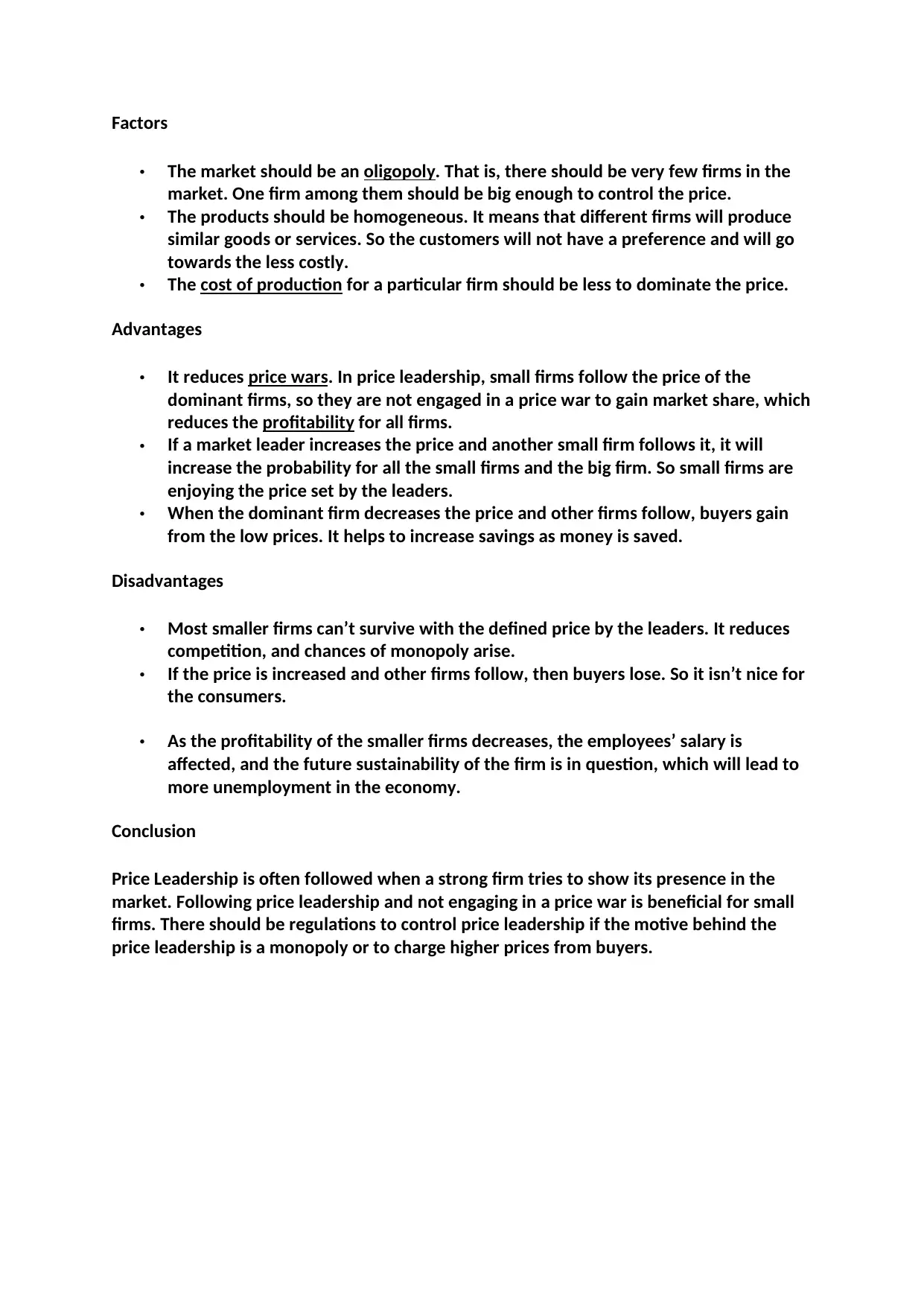
Factors
• The market should be an oligopoly. That is, there should be very few firms in the
market. One firm among them should be big enough to control the price.
• The products should be homogeneous. It means that different firms will produce
similar goods or services. So the customers will not have a preference and will go
towards the less costly.
• The cost of production for a particular firm should be less to dominate the price.
Advantages
• It reduces price wars. In price leadership, small firms follow the price of the
dominant firms, so they are not engaged in a price war to gain market share, which
reduces the profitability for all firms.
• If a market leader increases the price and another small firm follows it, it will
increase the probability for all the small firms and the big firm. So small firms are
enjoying the price set by the leaders.
• When the dominant firm decreases the price and other firms follow, buyers gain
from the low prices. It helps to increase savings as money is saved.
Disadvantages
• Most smaller firms can’t survive with the defined price by the leaders. It reduces
competition, and chances of monopoly arise.
• If the price is increased and other firms follow, then buyers lose. So it isn’t nice for
the consumers.
• As the profitability of the smaller firms decreases, the employees’ salary is
affected, and the future sustainability of the firm is in question, which will lead to
more unemployment in the economy.
Conclusion
Price Leadership is often followed when a strong firm tries to show its presence in the
market. Following price leadership and not engaging in a price war is beneficial for small
firms. There should be regulations to control price leadership if the motive behind the
price leadership is a monopoly or to charge higher prices from buyers.
• The market should be an oligopoly. That is, there should be very few firms in the
market. One firm among them should be big enough to control the price.
• The products should be homogeneous. It means that different firms will produce
similar goods or services. So the customers will not have a preference and will go
towards the less costly.
• The cost of production for a particular firm should be less to dominate the price.
Advantages
• It reduces price wars. In price leadership, small firms follow the price of the
dominant firms, so they are not engaged in a price war to gain market share, which
reduces the profitability for all firms.
• If a market leader increases the price and another small firm follows it, it will
increase the probability for all the small firms and the big firm. So small firms are
enjoying the price set by the leaders.
• When the dominant firm decreases the price and other firms follow, buyers gain
from the low prices. It helps to increase savings as money is saved.
Disadvantages
• Most smaller firms can’t survive with the defined price by the leaders. It reduces
competition, and chances of monopoly arise.
• If the price is increased and other firms follow, then buyers lose. So it isn’t nice for
the consumers.
• As the profitability of the smaller firms decreases, the employees’ salary is
affected, and the future sustainability of the firm is in question, which will lead to
more unemployment in the economy.
Conclusion
Price Leadership is often followed when a strong firm tries to show its presence in the
market. Following price leadership and not engaging in a price war is beneficial for small
firms. There should be regulations to control price leadership if the motive behind the
price leadership is a monopoly or to charge higher prices from buyers.
⊘ This is a preview!⊘
Do you want full access?
Subscribe today to unlock all pages.

Trusted by 1+ million students worldwide
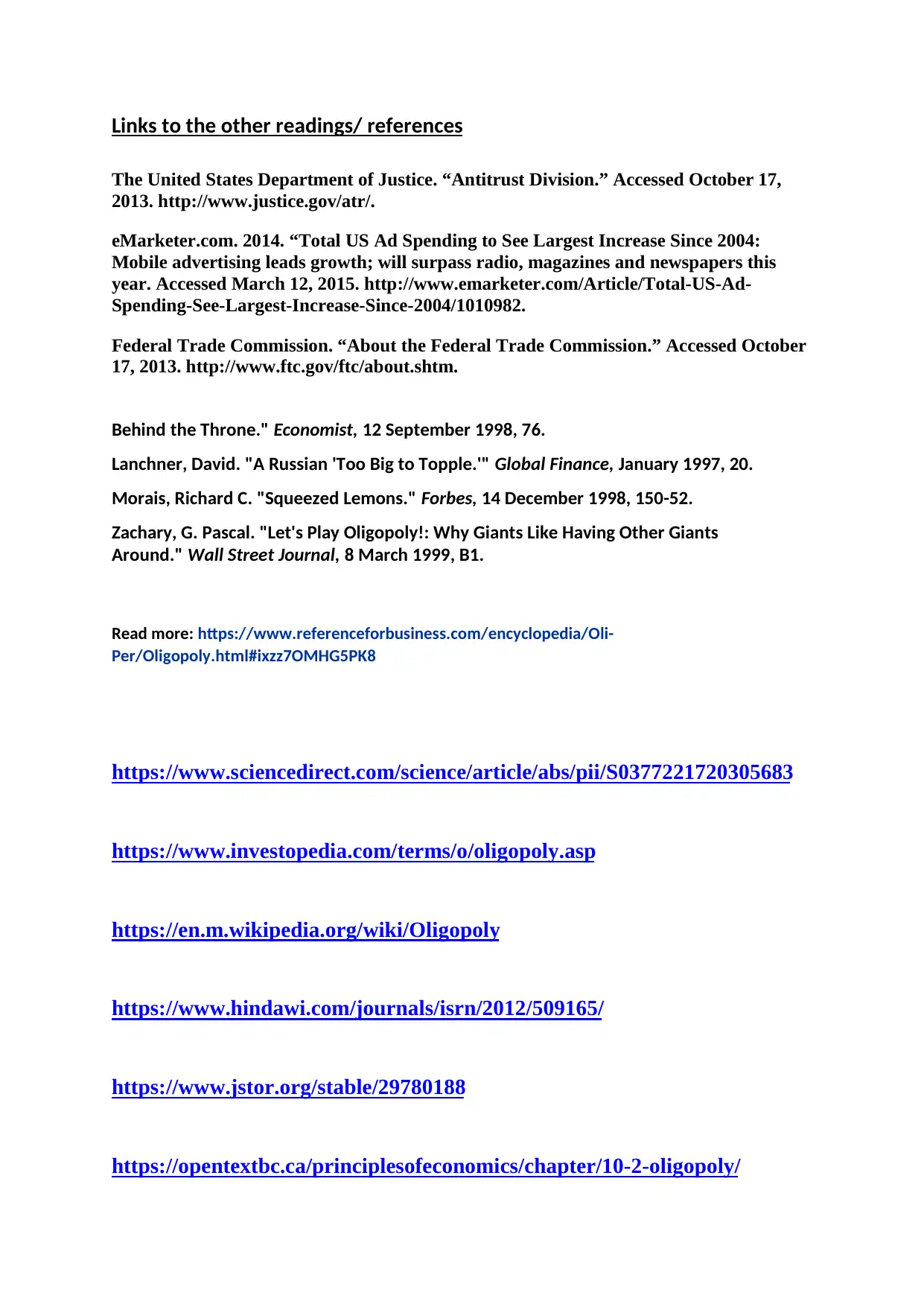
Links to the other readings/ references
The United States Department of Justice. “Antitrust Division.” Accessed October 17,
2013. http://www.justice.gov/atr/.
eMarketer.com. 2014. “Total US Ad Spending to See Largest Increase Since 2004:
Mobile advertising leads growth; will surpass radio, magazines and newspapers this
year. Accessed March 12, 2015. http://www.emarketer.com/Article/Total-US-Ad-
Spending-See-Largest-Increase-Since-2004/1010982.
Federal Trade Commission. “About the Federal Trade Commission.” Accessed October
17, 2013. http://www.ftc.gov/ftc/about.shtm.
Behind the Throne." Economist, 12 September 1998, 76.
Lanchner, David. "A Russian 'Too Big to Topple.'" Global Finance, January 1997, 20.
Morais, Richard C. "Squeezed Lemons." Forbes, 14 December 1998, 150-52.
Zachary, G. Pascal. "Let's Play Oligopoly!: Why Giants Like Having Other Giants
Around." Wall Street Journal, 8 March 1999, B1.
Read more: https://www.referenceforbusiness.com/encyclopedia/Oli-
Per/Oligopoly.html#ixzz7OMHG5PK8
https://www.sciencedirect.com/science/article/abs/pii/S0377221720305683
https://www.investopedia.com/terms/o/oligopoly.asp
https://en.m.wikipedia.org/wiki/Oligopoly
https://www.hindawi.com/journals/isrn/2012/509165/
https://www.jstor.org/stable/29780188
https://opentextbc.ca/principlesofeconomics/chapter/10-2-oligopoly/
The United States Department of Justice. “Antitrust Division.” Accessed October 17,
2013. http://www.justice.gov/atr/.
eMarketer.com. 2014. “Total US Ad Spending to See Largest Increase Since 2004:
Mobile advertising leads growth; will surpass radio, magazines and newspapers this
year. Accessed March 12, 2015. http://www.emarketer.com/Article/Total-US-Ad-
Spending-See-Largest-Increase-Since-2004/1010982.
Federal Trade Commission. “About the Federal Trade Commission.” Accessed October
17, 2013. http://www.ftc.gov/ftc/about.shtm.
Behind the Throne." Economist, 12 September 1998, 76.
Lanchner, David. "A Russian 'Too Big to Topple.'" Global Finance, January 1997, 20.
Morais, Richard C. "Squeezed Lemons." Forbes, 14 December 1998, 150-52.
Zachary, G. Pascal. "Let's Play Oligopoly!: Why Giants Like Having Other Giants
Around." Wall Street Journal, 8 March 1999, B1.
Read more: https://www.referenceforbusiness.com/encyclopedia/Oli-
Per/Oligopoly.html#ixzz7OMHG5PK8
https://www.sciencedirect.com/science/article/abs/pii/S0377221720305683
https://www.investopedia.com/terms/o/oligopoly.asp
https://en.m.wikipedia.org/wiki/Oligopoly
https://www.hindawi.com/journals/isrn/2012/509165/
https://www.jstor.org/stable/29780188
https://opentextbc.ca/principlesofeconomics/chapter/10-2-oligopoly/
Paraphrase This Document
Need a fresh take? Get an instant paraphrase of this document with our AI Paraphraser
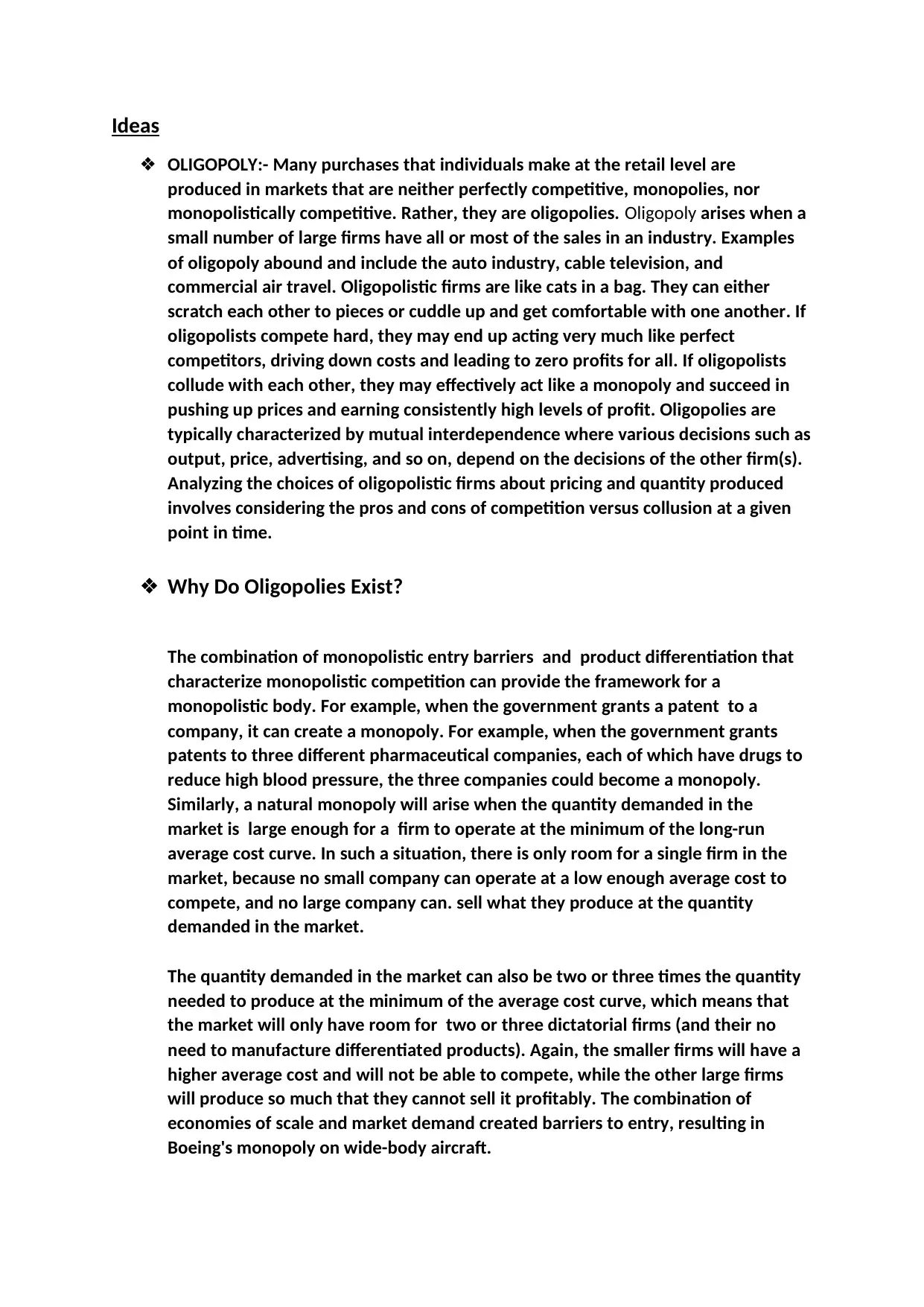
Ideas
❖ OLIGOPOLY:- Many purchases that individuals make at the retail level are
produced in markets that are neither perfectly competitive, monopolies, nor
monopolistically competitive. Rather, they are oligopolies. Oligopoly arises when a
small number of large firms have all or most of the sales in an industry. Examples
of oligopoly abound and include the auto industry, cable television, and
commercial air travel. Oligopolistic firms are like cats in a bag. They can either
scratch each other to pieces or cuddle up and get comfortable with one another. If
oligopolists compete hard, they may end up acting very much like perfect
competitors, driving down costs and leading to zero profits for all. If oligopolists
collude with each other, they may effectively act like a monopoly and succeed in
pushing up prices and earning consistently high levels of profit. Oligopolies are
typically characterized by mutual interdependence where various decisions such as
output, price, advertising, and so on, depend on the decisions of the other firm(s).
Analyzing the choices of oligopolistic firms about pricing and quantity produced
involves considering the pros and cons of competition versus collusion at a given
point in time.
❖ Why Do Oligopolies Exist?
The combination of monopolistic entry barriers and product differentiation that
characterize monopolistic competition can provide the framework for a
monopolistic body. For example, when the government grants a patent to a
company, it can create a monopoly. For example, when the government grants
patents to three different pharmaceutical companies, each of which have drugs to
reduce high blood pressure, the three companies could become a monopoly.
Similarly, a natural monopoly will arise when the quantity demanded in the
market is large enough for a firm to operate at the minimum of the long-run
average cost curve. In such a situation, there is only room for a single firm in the
market, because no small company can operate at a low enough average cost to
compete, and no large company can. sell what they produce at the quantity
demanded in the market.
The quantity demanded in the market can also be two or three times the quantity
needed to produce at the minimum of the average cost curve, which means that
the market will only have room for two or three dictatorial firms (and their no
need to manufacture differentiated products). Again, the smaller firms will have a
higher average cost and will not be able to compete, while the other large firms
will produce so much that they cannot sell it profitably. The combination of
economies of scale and market demand created barriers to entry, resulting in
Boeing's monopoly on wide-body aircraft.
❖ OLIGOPOLY:- Many purchases that individuals make at the retail level are
produced in markets that are neither perfectly competitive, monopolies, nor
monopolistically competitive. Rather, they are oligopolies. Oligopoly arises when a
small number of large firms have all or most of the sales in an industry. Examples
of oligopoly abound and include the auto industry, cable television, and
commercial air travel. Oligopolistic firms are like cats in a bag. They can either
scratch each other to pieces or cuddle up and get comfortable with one another. If
oligopolists compete hard, they may end up acting very much like perfect
competitors, driving down costs and leading to zero profits for all. If oligopolists
collude with each other, they may effectively act like a monopoly and succeed in
pushing up prices and earning consistently high levels of profit. Oligopolies are
typically characterized by mutual interdependence where various decisions such as
output, price, advertising, and so on, depend on the decisions of the other firm(s).
Analyzing the choices of oligopolistic firms about pricing and quantity produced
involves considering the pros and cons of competition versus collusion at a given
point in time.
❖ Why Do Oligopolies Exist?
The combination of monopolistic entry barriers and product differentiation that
characterize monopolistic competition can provide the framework for a
monopolistic body. For example, when the government grants a patent to a
company, it can create a monopoly. For example, when the government grants
patents to three different pharmaceutical companies, each of which have drugs to
reduce high blood pressure, the three companies could become a monopoly.
Similarly, a natural monopoly will arise when the quantity demanded in the
market is large enough for a firm to operate at the minimum of the long-run
average cost curve. In such a situation, there is only room for a single firm in the
market, because no small company can operate at a low enough average cost to
compete, and no large company can. sell what they produce at the quantity
demanded in the market.
The quantity demanded in the market can also be two or three times the quantity
needed to produce at the minimum of the average cost curve, which means that
the market will only have room for two or three dictatorial firms (and their no
need to manufacture differentiated products). Again, the smaller firms will have a
higher average cost and will not be able to compete, while the other large firms
will produce so much that they cannot sell it profitably. The combination of
economies of scale and market demand created barriers to entry, resulting in
Boeing's monopoly on wide-body aircraft.
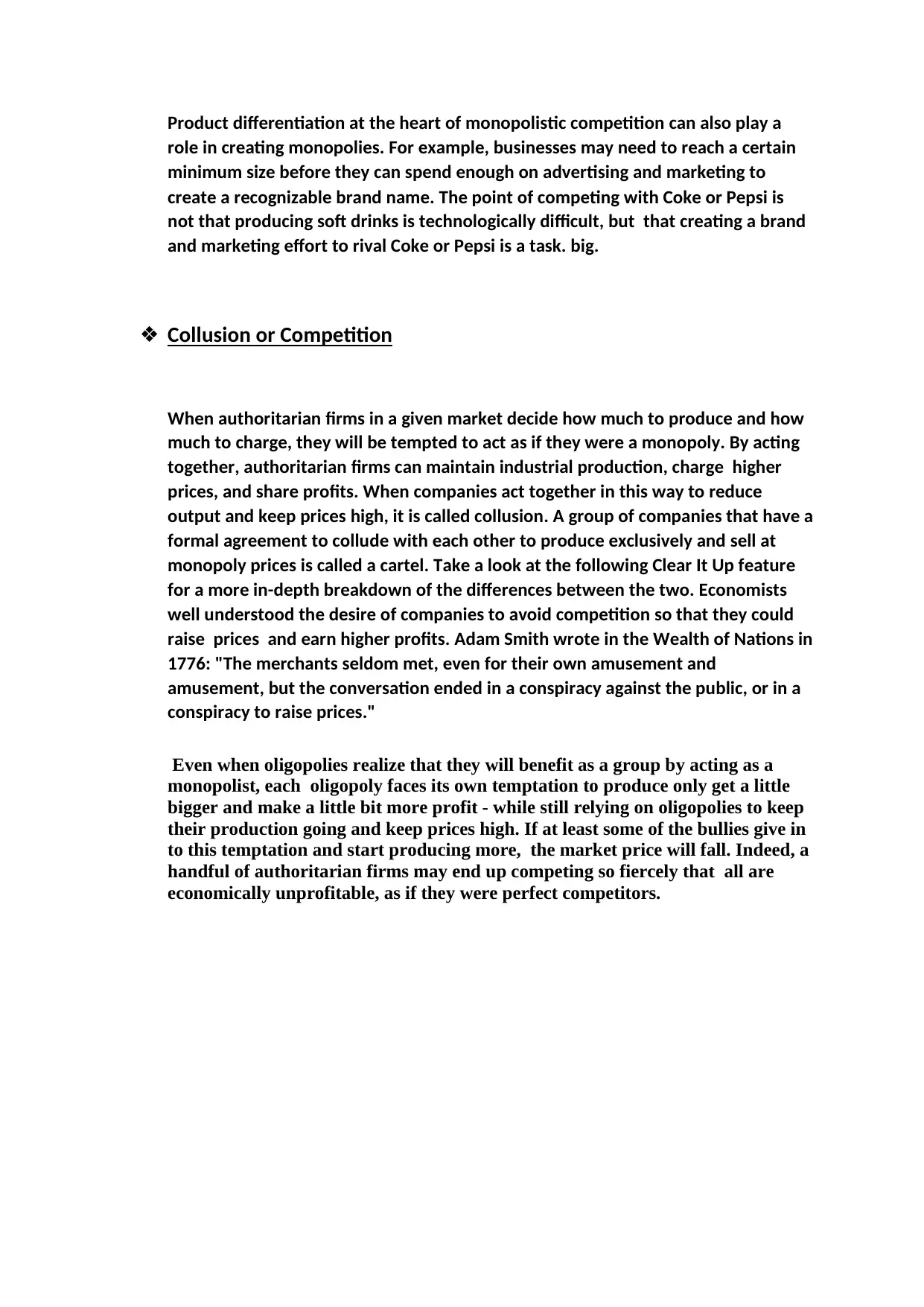
Product differentiation at the heart of monopolistic competition can also play a
role in creating monopolies. For example, businesses may need to reach a certain
minimum size before they can spend enough on advertising and marketing to
create a recognizable brand name. The point of competing with Coke or Pepsi is
not that producing soft drinks is technologically difficult, but that creating a brand
and marketing effort to rival Coke or Pepsi is a task. big.
❖ Collusion or Competition
When authoritarian firms in a given market decide how much to produce and how
much to charge, they will be tempted to act as if they were a monopoly. By acting
together, authoritarian firms can maintain industrial production, charge higher
prices, and share profits. When companies act together in this way to reduce
output and keep prices high, it is called collusion. A group of companies that have a
formal agreement to collude with each other to produce exclusively and sell at
monopoly prices is called a cartel. Take a look at the following Clear It Up feature
for a more in-depth breakdown of the differences between the two. Economists
well understood the desire of companies to avoid competition so that they could
raise prices and earn higher profits. Adam Smith wrote in the Wealth of Nations in
1776: "The merchants seldom met, even for their own amusement and
amusement, but the conversation ended in a conspiracy against the public, or in a
conspiracy to raise prices."
Even when oligopolies realize that they will benefit as a group by acting as a
monopolist, each oligopoly faces its own temptation to produce only get a little
bigger and make a little bit more profit - while still relying on oligopolies to keep
their production going and keep prices high. If at least some of the bullies give in
to this temptation and start producing more, the market price will fall. Indeed, a
handful of authoritarian firms may end up competing so fiercely that all are
economically unprofitable, as if they were perfect competitors.
role in creating monopolies. For example, businesses may need to reach a certain
minimum size before they can spend enough on advertising and marketing to
create a recognizable brand name. The point of competing with Coke or Pepsi is
not that producing soft drinks is technologically difficult, but that creating a brand
and marketing effort to rival Coke or Pepsi is a task. big.
❖ Collusion or Competition
When authoritarian firms in a given market decide how much to produce and how
much to charge, they will be tempted to act as if they were a monopoly. By acting
together, authoritarian firms can maintain industrial production, charge higher
prices, and share profits. When companies act together in this way to reduce
output and keep prices high, it is called collusion. A group of companies that have a
formal agreement to collude with each other to produce exclusively and sell at
monopoly prices is called a cartel. Take a look at the following Clear It Up feature
for a more in-depth breakdown of the differences between the two. Economists
well understood the desire of companies to avoid competition so that they could
raise prices and earn higher profits. Adam Smith wrote in the Wealth of Nations in
1776: "The merchants seldom met, even for their own amusement and
amusement, but the conversation ended in a conspiracy against the public, or in a
conspiracy to raise prices."
Even when oligopolies realize that they will benefit as a group by acting as a
monopolist, each oligopoly faces its own temptation to produce only get a little
bigger and make a little bit more profit - while still relying on oligopolies to keep
their production going and keep prices high. If at least some of the bullies give in
to this temptation and start producing more, the market price will fall. Indeed, a
handful of authoritarian firms may end up competing so fiercely that all are
economically unprofitable, as if they were perfect competitors.
⊘ This is a preview!⊘
Do you want full access?
Subscribe today to unlock all pages.

Trusted by 1+ million students worldwide
1 out of 17
Related Documents
Your All-in-One AI-Powered Toolkit for Academic Success.
+13062052269
info@desklib.com
Available 24*7 on WhatsApp / Email
![[object Object]](/_next/static/media/star-bottom.7253800d.svg)
Unlock your academic potential
Copyright © 2020–2025 A2Z Services. All Rights Reserved. Developed and managed by ZUCOL.





